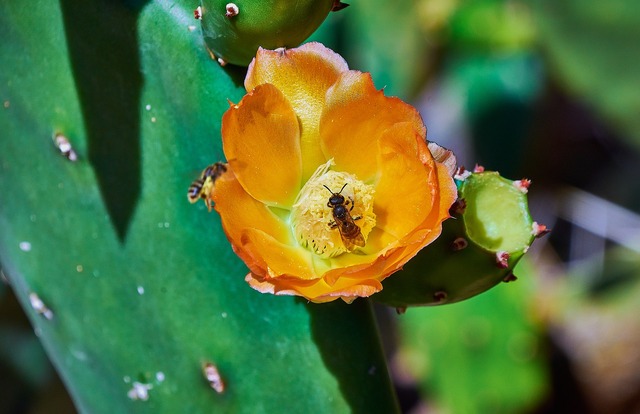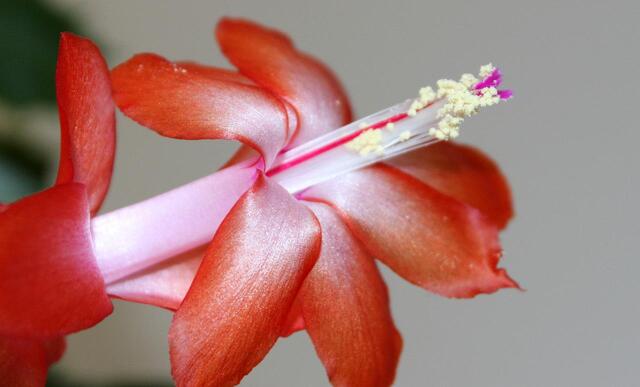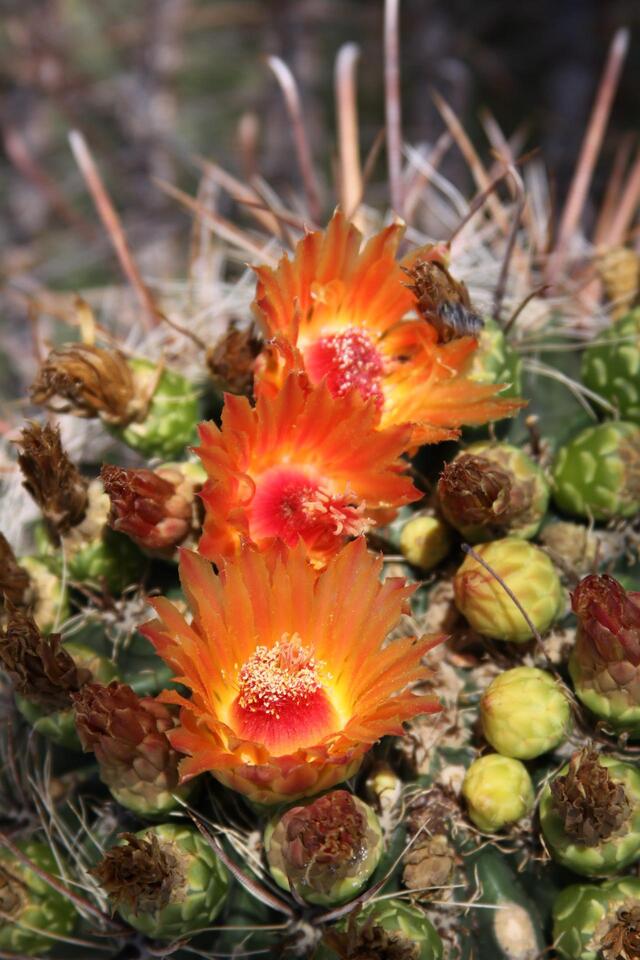When it comes to cacti, an orange flower isn’t entirely uncommon. You have several species of cacti that can grow orange flowers. The striking color and the pleasant aroma of a cactus flower has led to it becoming a favorite. Meanwhile, they attract pollinators such as bats and bees. Yes, you read that right, bats serve as quintessential pollinators in tropical and desert climates where they will free the cacti from pests by feeding on them. Over 300 species of fruit depend on bats for pollination.
Types of Cactus with Orange Flowers
- Prickly pear cactus
- Barrel cactus
- Christmas cactus
- Organ pipe cactus
- Moon cactus
- Desert gem
- Crown cactus
- Orange snowball cactus
- Claret cup cactus
- Red Tom Thumb Cactus
- Easter cactus
What Determines Flower Color?
The color of the flower occurs due to the reflected light of various chemical compounds known as plant pigments. You may see a cactus with a red flower turn orange over time. Color changes in a flower indicate that the flower has matured past the pollination stage.
Hot temperatures and direct sunlight can fade flower color, which explains why the flower occasionally changes from red to orange. Contrasted with cool weather, the flower colors may become more intense.
With each cactus, when they flower and how they flower will depend on the species of cactus. The orange color may vary as well. Stay tuned as we cover each of these cactuses and how their orange flower looks.
Prickly Pear Cactus

The prickly pear cactus will occasionally produce a beautiful orange-yellow flower. While many love it for its flower and its fruit, they fear it for its fearsome spines. You may see the prickly pear cactus turn color over time. For example, it may start out yellow and grow orange over time. Once the prickly pear reaches maturity, you may see a bright red flower. The prickly pear produces wonderful flowers, but it will later give you an equally delicious fruit.
You typically see the prickly pear cactus bloom in the spring to early summer. The blossoms will usually be large and breathtaking.
Even if the flower looks yellow, check the inside of the flower to see if it doesn’t look orange or red on the inside. Prickly pear refers to a plant genus of about 100 species, so it’s a broad topic to cover. Two examples of the prickly pear cacti species with orange flowers include Englemann’s Prickly Pear and the Desert Gem, but you have many others.
Barrel Cactus
The Barrel Cactus has different flowers from that of the prickly pear in that the reddish-orange petals will form at the crown of the cactus. If you want true orange flowers from the barrel cactus, choose the Mexican Flame Cactus since this gives you the only clumping barrel cactus that has a true orange flower.
The other ones do have orange, but it mixes in with a lot of red or yellow. In some cases, the barrel cactus may even have a purple flower. While rare, the barrel cactus will occasionally produce a fruit that you can eat. You can even eat this fruit raw. It has a light and lemony flavor with shiny black seeds. Still, you probably choose this over Saguaro cactus fruit or the prickly pear fruit.
You will typically see blooms on the barrel cactus starting in April. In some cases, the Barrel Cactus will flower up until September, but you rarely see it flower after October.
Orange and yellow flowers are the most common, but pink and red do occur from time to time. Once the flowers begin to wilt around May, you may see the flower change to another color.
Christmas Cactus

The Christmas Cactus has a reputation for its bright blooms and it blooms in a variety of colors including orange. They bloom during the Christmas season, which was how this plant received its name. In some cases, you may see this plant flower with a yellow-orange flower.
While this plant readily adapts to conditions with low light, they bloom best in bright and indirect sunlight. You don’t want to place it in full sunlight because it produces a dark red on its leaves when burnt. Pay attention to the light and the temperature to see orange blossoms. The perfect temperature for blooming sits between 50 to 55 degrees Fahrenheit. Beware of too hot or too cold of drafts since this can damage the blooms.
Keep the Christmas Cactus away from heated vents and leaky doors. The drafts can prevent flowers.
Organ Pipe Cactus
Blooming from April to June, the organ pipe cactus often has white flowers. This cactus is known for the large and bright orange flowers that it produces. Many times, this cactus produces a bright reddish-orange flower. The orange flowers on this cactus develop in the center of the plant. The organ pipe cactus can live for up to 150 years, and it doesn’t produce its first flower until the age of 35 when it matures.
This shows us the second largest cactus species in the United States, which can grow up to 24 feet tall. The first largest species is the Mexican giant Cardon cactus, which can reach up to 63 feet tall.
Most of the time, this cactus will bloom at night, and the flowers grow at the tip of the stems. You can find this cactus in its native habitat in southern Arizona in the Sonora Desert. Just keep in mind that the orange flowers aren’t as common as the white or lavender with this one.
The Moon Cactus

Many love the moon cactus, and you can buy this one in a variety of colors including orange. Oftentimes, newcomers to the moon cactus will mistake the top-colored part for the flower. In fact, that is grafted onto the plant. While one moon cactus might be short and fat, you have others that are thin and tall.
In some cases, the moon cactus prospers and you will get flowers out of it. Orange and yellow give us the most common color of moon cactus.
When this cactus blooms, the flower will usually only last for 12 hours. About once a year after the plant matures, it will produce flowers. You may want to give it more moisture during this time since it will produce more blossoms. Like most cacti, the moon cactus uses water and sunlight as energy to produce blossoms.
This is a slow-growing cactus compared to other species. You wouldn’t buy this one for its miraculous growth, but many cacti don’t grow quickly.
Related Article: Expert Guide: Red Cactus Flower
Desert Gem
Considered a small variety of the prickly pear cactus, you will see this cactus produce orange flowers from time to time. When it blooms, the desert gem has vibrant orange flowers. This cactus blooms in the spring and summer season. In its native habitat in Mexico, it can grow up to 24 inches tall.
You would categorize the desert gem as an indoor cactus species. They don’t require much care, and they need minimal amount of water to produce flowers. Using some tomato fertilizer, however, will encourage it to produce its vibrant orange blossoms. You want to keep this cactus in the light to help it produce its flowers since it loves the sunlight.
Crown Cactus
The orange flowers on the crown cactus are very beautiful and appealing. Once it produces a flower, you will see it make bright orange and daisy-like flowers. They call this cactus a free-flowering species, which means that it has a continuous flowering cycle throughout the growing season. They bloom throughout the spring of the year.
Many times, the stems will be covered in thorns, and they produce a delicate flower.
Orange Snowball Cactus
You can choose to put the orange snowball cactus either inside or outdoors. Place it in an area where it can absorb the morning sun. The gorgeous orange blossoms on the orange snowball cactus will catch your attention right away. Younger orange snowball cactus will often produce a big and yellow flower, but the older plants tend to produce red, pink and orange flowers.
Many consider the orange snowball cactus a highly ornamental plant because of its bright colors. This plant grows its best when you position it in full sunlight. The sunlight will help it to produce energy for flowers as well.
You can typically expect to see this cactus bloom in the spring. They call this a snowball cactus because the thick, white spines on it make it appear like a snowball.
Claret Cup Cactus
The claret cup cactus produces a flower that looks orange or red, but it looks like one of the most beautiful of flowers. The bright red and orange flowers will often cover this cactus. This cylindrical and low-growing plant has a dense and spiny surface. The spines on this one fall off seasonally.
Many people cultivate the claret cup cactus because of its beautiful orange flowers. This cactus can thrive in conditions with little water and extreme temperatures. You will see it bloom after five to 10 years, and the blooming usually happens from April to June.
You can find this native plant growing wild in the southwestern part of the United States like California, Arizona, New Mexico and Texas. You will find this cactus growing in Mexico as well. This desert dweller likes to grow in gravelly soil.
Red Tom Thumb Cactus
This small globe-shaped cactus has red, pink or orange flowers depending on the plant. It produces them in the spring and summer of the year. Most of the time, the flowers will be orange with a red tinge. This plant can reach up to 15 cm in height. The flowers will usually be about 3 cm across.
The cactus grows its best in bright sunlight. You will want to use well-drained soil to prevent root rot, which is common for any cactus with poor drainage.
Beware of this cactus because it does have some sharp spines on it that you don’t want to touch. Many times, you will see this cactus used as filler for rocky gardens.
Easter Cactus

The Easter Cactus got its name because it usually blooms around the Easter season. The orange blooms will usually be about 2 inches across. You can expect this cactus to bloom anywhere from March to May. This cactus is interesting in that its orange blooms will open each morning, and they will close every night.
You can expect the Easter Cactus to flower once a year, but they have been known to flower twice in a year. Usually, drier and cooler conditions of about 50 degrees Fahrenheit will suit it best at night. Don’t place this cactus near cool drafts or directly next to a heat source since it can prevent it from producing its soft orange flowers.
Usually, a warmer home will do better because the blooming season will start earlier for the cactus. This isn’t like a desert cactus, and the Easter Cactus does better in cooler temperatures.
How long the blooms continue for will depend on the growing conditions of your plant. Many people like to buy an Easter Cactus even during its blooming season. It’s not uncommon.
What Triggers the Orange Flowers on a Cactus?
What makes a cactus bloom so well has to do with three factors: water deprivation, bright light and semi-dormancy in the winter. All of this contributes to the cactus producing bright orange flowers in abundance come the spring of the year. Many cacti will produce flowers in the spring season as they come out of dormancy. Once the spring season hits and you start to water them again more frequently, it brings them out of that stage to produce beautiful flowers.
Final Thoughts
I have highlighted 11 cacti here that produce orange flowers. That doesn’t cover all of them, but it gives you an idea. Some of them will flower easier than others, and you may struggle to get an orange bloom with some since most cacti never produce just a single color. You usually have the potential for them to produce a variety of flower colors.
If you’d like to learn more about the cactus and its flowers, I wrote another one here about yellow cactus flowers. Learn about the different varieties of cacti that produce yellow flowers to help you on your quest to collect different flower colors.

